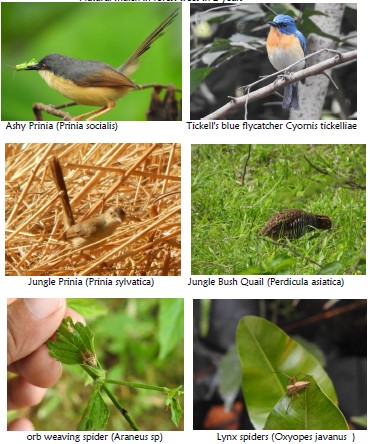
PROJECT BACKGROUND
A two-year forest restoration work in the Green Belt area of Vedanta limited at Navelim Goa was completed and handed over in Oct 2023. The project was initiated in July 2021.
Forest restoration inside the industry was planned with the vision to-
a. Decrease air particles emitted during the iron ore processing
b. Minimize sound pollution
c. Create green pocket for the local biodiversity
A ‘green belt’ concept is the planting of pollution-tolerant trees, for minimizing air pollution by filtering, and absorbing pollutants in an effective manner to improve the environment.
Forestry was carried out with Miyawaki forest restoration technique. Miyawaki forestry technique is for restoration of degraded land into forest. Miyawaki forest restoration technique is based on ecological principles of forest restoration where the original forest ecosystem gets replicated in terms of density and diversity.
As the selected area is adjacent to the ore processing area, selection of appropriate plant species was very important to ensure a self-sustainable vegetation cover. Selection of the trees is critical in Miyawaki forest restoration technique.
For restoration, trees are also required to provide food and habitat for declining birds-insects-mammals populations. As pressures increase steadily from growing human populations and climate change, it is essential to grow trees which can support biodiversity. Many such tree species were selected which bear fruits throughout the year and which support rich biodiversity down the years. The direct benefits of forest trees on the land are forest products such as fruits, medicinal produce, provides shade, and increased moisture in the area. Indirect benefit includes environmental and ecological benefits includes-
1. Increase in water holding capacity of soil
2. Increase in water table
3. Cooler microclimatic conditions
4. Absorption of pollutants
5. Maintained soil nutrition
6. Soil reclamation
7. Carbon sequestration
8. Increased biodiversity
For restoration 7550 saplings of 137 species of native, ecologically suitable trees and shrubs were selected.
For restoration of forests, preparation of the ground is essential. Soil test was carried to understand the soil nutrient profile. Soil amendments were determined as per the soil test. Adding organic amendments is essential to facilitate the establishment and colonization of forest in a degraded land, devoid of original vegetation. Soil was dug and Organic material was added to the each of the selected areas.


The forestry drive was carried out on the prepared grounds in the monsoon season. Volunteers from Vedanta participated in the forestry drive.


All the three areas were covered with dry paddy stalks. Covering the soil saves water by preventing surface evaporation and reduces water requirement by locking water on the surface below. Mulching the soil is replicating the natural forest floor till the forest gets established. The saplings were supported by bamboo sticks till they grew strong enough.

Post forestry two years maintenance was carried out regularly. Drip irrigation system was installed on all the three areas. Caretakers removed weeds from and around the restored areas regularly for two years. Mulching of all the areas was carried out once a year for two years. Women from nearby villages were employed for this.

To verify the results of the restoration, following activities were carried out.
- Stage wise growth of forest trees in each area was measured
- Seasonal growth and changes were monitored
- Flowering and fruiting stages of forest trees were documented
- Natural mulch formation at forest was documented
- Height of the tree species were measured regularly
- Biodiversity observed inside forest was documented

After 2 years of restoration, a self sustaining forest has been created rich in biodiversity.

Documented biodiversity at site


